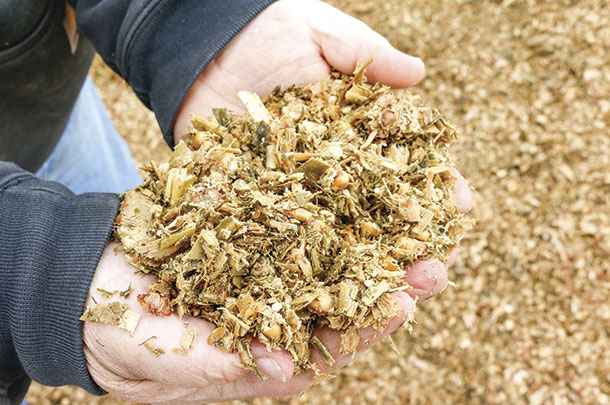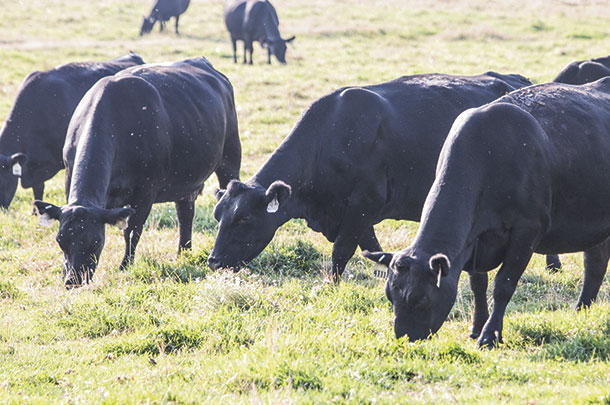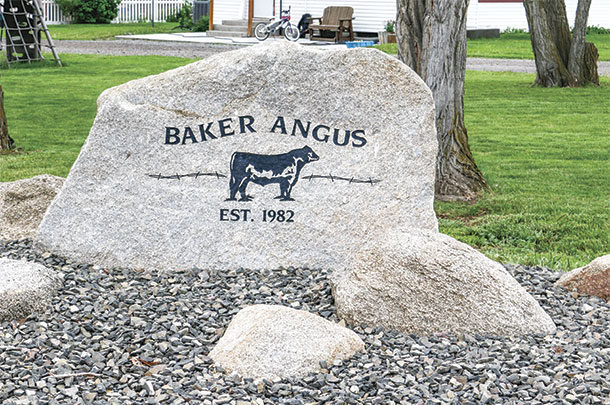Baker says he ran it solo for 16 years until it got too big for one man to run alone, and he hired Sam Mahler in 1998 as his first full-time ranch hand.
Mahler has witnessed a lot of the growth and change of Baker Angus in the almost-19 years he has worked there, now as ranch foreman. “We’ve built this thing up from the ground,” he says. Mahler says they currently sell 150 to 200 bulls each year and run a registered Angus herd of roughly 500 cow-calf pairs.
In addition to the 900 acres in Vale, they graze about 1,600 acres of leased/owned ground in Halfway, Oregon, and Indian Valley, Idaho.
Self-taught silage
In his years of working on a ranch, Mahler has never stopped learning and exploring improvements in the ag industry. Mahler feeds a mixed ration of grass, alfalfa hay and corn silage to his bulls and grows the silage corn himself.

Mahler had no previous experience growing, harvesting or storing silage and taught himself the process by talking to other producers who grew it and thoroughly researching the topic in every ag magazine he could find.
“I didn’t grow up raising corn,” he says. “My dad had a silage pit when I was a kid, but I had no experience with it myself.” He says learning how to make silage was a process of paying close attention to what was happening and always asking questions.
“Every time you pull a tractor, you learn something,” he says. “I didn’t have much of an education, as far as college goes, so my dad would always say to me, ‘Watch and learn,’ and I did.”
Mahler also double-crops his fields. He plants barley and peas in spring, harvests them in June and then plants corn and harvests it in the fall for silage. “You’ve got to be on the ball to double-crop,” he says. “It’s not for people who can’t make things happen.”
Long-distance grazing
Mahler grazes his cow-calf pairs and heifers on roughly 600 acres of leased ground near Halfway, Oregon, about 140 miles from Vale and on about 1,000 acres of owned property in Indian Valley, Idaho, about 80 miles away. Cows are transported to their summer pasture around May 1 and remain until early November.
They operate on a fall calving schedule, which works well with their grazing system. Mahler and his brother, who also works for the ranch, used to make the nine-hour round trip out to each of the grazing grounds every three days to tag and record new calves.
This year, to save time and money, they sent a hired hand to stay in Halfway for the first month of calving to relieve some of the pressure of their busy fall season.
Mahler says transporting the cattle to grazing grounds far away is cost-effective in several ways. First, it allows them to focus on growing hay and other crops on the home ranch during the summer.
Second, the cattle have more room to themselves and can more easily avoid the diseases the more cramped circumstances at the home ranch would generate.
“When you’ve got all of those cattle grouped tight on smaller pastures, you’ve got a lot more sickness and a lot more problems that you don’t have out on the range,” he says. “When you start doctoring cattle, the cost is so much higher it’s worth transporting them that far.”
Another benefit is the different weather patterns in each area that ensure each group of cattle will have enough grass. “Usually not every weather pattern is short on grass at the same time,” he says. “We chose [Indian Valley] because we wanted a different weather pattern; that way you don’t get pinched everywhere.”
Mahler saves the home ranch ground for winter feeding. After the crops are in and the hay is cut, the cattle return and graze another month’s worth of forage off the fields before they start feeding hay.
Rangeland rehab
The now-productive Indian Valley acreage is another proof of Mahler’s ongoing learning. When Baker Angus purchased the grazing land in Indian Valley, the grass had been so overgrazed it was producing far below its potential, and every fence was almost flat on the ground.
“The neighbor cows were so used to coming over and grazing that there were cow trails right across the fenceline,” Mahler says. The first thing on the to-do list was fixing the fence. “The fences there were a fright,” Baker says.
Mahler again turned to ag magazines and the advice of his peers for help in turning the stripped, starved ground back to full grass production. He started out by undergrazing for the first few years. “We really just needed to give it a rest,” he says. “It needed some time to grow back and get healthy again, so we just let it do that.”
They also took the cows off early to give the grass a chance to go to seed and replace itself. “We knew the seed was there, so we let it just come. We didn’t get in a hurry there,” he says.

He says that after a few years of fighting thistle and whitetop, the weed population should be low enough for them to be able to introduce a few new ryegrass varieties where the previous owners used to dryland farm.
“I could probably triple my production with them,” he says. Mahler says the idea for planting ryegrasses also came from reading up on range management in ag magazines.
Continual learning
Magazine articles and industry advice aren’t the only resources Mahler puts to good use. “I sell bulls and talk to a lot of people from Nevada to Washington, and when I meet them, I ask questions. You learn a lot that way,” he says. “A lot of these guys are older and know how to manage their range really well. I find out what works for them, and I try to apply that knowledge to my own situation. I’ve still got a lot to learn.”
Baker says keeping up with the continual stream of available information is an essential part of their success as an operation. He says they use everything from online information to publications to visits to other cattle operations to help improve their business.
“You’ve got to change with the times, and they’re always changing,” he says. “It’s an ongoing education process, seeing what’s going on around you and learning more about what people want. They keep changing all the time, so you’ve got to keep changing with it.” ![]()
PHOTO 1: A gift to Jerry Baker from Mahler and family and wife Judy Baker.
PHOTO 2: Mahler taught himself to make his own silage, which he feeds in a TMR to his bulls.
PHOTO 3: Bred cows in August in Indian Valley, Idaho. Photos by Carrie Veselka.

-
Carrie Veselka
- Associate Editor
- Progressive Forage
- Email Carrie Veselka











